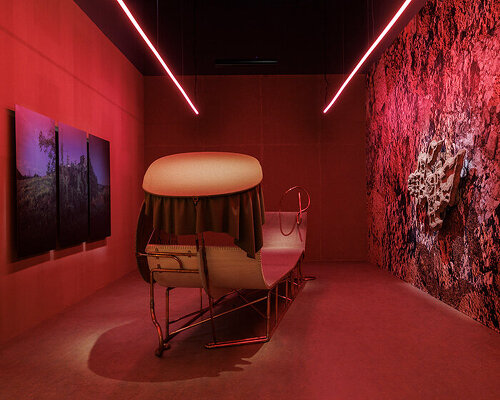The Polish Pavilion at the triennale milano asks who gets to rest
In response to this year’s Triennale Milano International Exhibition theme, Inequalities, the Polish Pavilion becomes a sanctuary for both human and ecological bodies, exhausted by capitalism, climate crisis, and care work. Curator Katarzyna Roj and architect Aleksandra Wasilkowska share more about A Brief Vacation with designboom, their show that reimagines the ancient tepidarium as a contemporary chamber of collective rest. ‘Rest,’ Katarzyna Roj tells us, ‘is not something to outsource to individual willpower. It’s something we need a policy for.’
Beneath the vaulted halls of the Palazzo dell’Arte, visitors are invited into the transsanatorium, a sensorial refuge that rethinks how cities distribute comfort, challenging the structural inequalities that determine who gets to rest and who doesn’t. A Brief Vacation asks, who can afford stillness in the burnout economy? Through immersive installation, sculpture, scent, sound, and movement, the pavilion reflects on the distribution of peace and bodily care. Roj’s vision, together with Wasilkowska’s design, turns urban infrastructure inside out, reimagining it as a sanctuary where marginalized bodies, caregivers, migrants, and frontline workers, can pause, regenerate, and be seen. Rest, often seen as a luxury, is here reframed as a basic hygiene that demands public policy. ‘This profound fatigue,’ the curator continues, ‘is not only dedicated to humans but also to ecological systems and exhausted resources. We need to think about how we can build infrastructure of care for all of that.’
image by Jacopo Salvi, Altomare.studio
A Brief Vacation revives affordable hygiene rituals
The project, part of the 24th Triennale Milano International Exhibition, takes its title and its concept from Vittorio De Sica’s 1973 film Una breve vacanza, where a Milanese factory worker finds unexpected dignity and healing in a mountain sanatorium. ‘It tells the story of Clara,’ explains curator Katarzyna Roj. ‘A Milanese working-class hero who gets tuberculosis and is sent to a sanatorium in the mountains. There, she gets her own room, with good food, and with the whole infrastructure of care, she experiences a social uplift. And this became a starting point for us—to ask, who has the right to rest, especially in times of mass migration, war, and reproductive work?’ The pavilion builds on this cinematic starting point to ask who today is allowed to rest and who is excluded. For Roj, hygiene should not be left to the individual. ‘We need to think of rest as collective infrastructure, especially in the context of mass migration, ecological fatigue, and reproductive labor,’ she adds.
The Polish Pavilion, organized by the Adam Mickiewicz Institute with support from BWA Wrocław Galleries of Contemporary Art, builds on the legacy of spaces like Milan’s subterranean Albergo Diurno Venezia, once offering affordable hygiene rituals to working-class residents. Wasilkowska’s design revives this spirit through a transcultural lens, proposing a network of future urban grottos: small-scale sanctuaries responding to crises of heat, drought, and displacement with care. These spaces could integrate with metro infrastructure, capturing underground temperatures, filtering rainwater, and offering emergency sanitation services in overheated cities. ‘Usually when you build a metro, you excavate around one million tons of earth,’ says the Warsaw-based architect during our interview. ‘That soil is transported outside of the city. We want to reuse it, to build a healing mountain next to the station—with sanitary infrastructure inside, like a cross-section of the future?’ One such ‘healing mountain’ is envisioned as a layered grotto of transcultural bathing rituals and rest zones. ‘We’re not just asking who gets to rest,’ states Roj. ‘We’re asking how we build for it—across borders, species, and systems.’
Polish Pavilion becomes a sanctuary for exhausted bodies
The transsanatorium combines global sanitary typologies
The underground chambers draw from global sanitary typologies. The transsanatorium incorporates a transcultural matrix of public bath typologies. ‘My idea was: how can we think of public space for nomads and diasporas living in the city?’ explains Wasilkowska. ‘Inside the healing mountain, there’s a mikveh, a mezzakal from South America, Greek and Roman baths, a Japanese sento, and even a ghat from Hindu culture. It’s like a protopian-utopian mix, because cities today aren’t monocultures anymore.’
This pluralistic approach extends even to sanitary architecture. ‘Toilets, for example, should have squatting and sitting options next to each other, you never know who will come. I saw it at the Istanbul airport, and I really appreciated it,’ the architect argues. ‘Migration is accelerating, and we need to adapt our designs to the people who live in our cities, not some imaginary standard user.’
In the age of hustle culture and planetary exhaustion, A Brief Vacation also confronts deeper taboos. ‘Lying down in public space is forbidden in European cities—it’s a class issue,’ Wasilkowska adds. ‘This idea is also about redistribution of luxury. It’s cheap—built from waste—but it’s for everyone. You don’t have to travel to an expensive sanatorium. It’s right here, in the metro.’
The pavilion’s central chamber features a sculpted daybed by artist Olaf Brzeski, soundscapes by Antonina Nowacka, and custom fragrances by Monika Opieka, aiming at sensual immersion. ‘We want people to lie down, to slow down, to notice their body in space,’ notes Roj.
a brief vacation reimagines the ancient tepidarium as a chamber of collective rest
challenging the structural inequalities that determine who gets to rest and who doesn’t
Roj’s vision, together with Wasilkowska’s design, turns urban infrastructure inside out
a sanctuary where marginalized bodies can pause, regenerate, and be seen
rest, often seen as a luxury, is here reframed as a basic hygiene that demands public policy
the project takes its title and its concept from Vittorio De Sica’s 1973 film Una breve vacanza
Polish Pavilion builds on the legacy of spaces like Milan’s subterranean Albergo Diurno Venezia
the transsanatorium incorporates a transcultural matrix of public bath typologies
custom fragrances by Monika Opieka aim at sensual immersion
A Brief Vacation confronts deeper taboos
Wasilkowska’s urban proposal could integrate with metro infrastructure
project info:
name: Polish Pavilion, 24th Triennale Milano International Exhibition | @triennalemilano
exhibition title: A Brief Vacation
location: Triennale Milano, Milan, Italy
dates: May 13 – November 9, 2025
curator: Katarzyna Roj | @krojczy
architect of transsanatorium: Aleksandra Wasilkowska | @shadowarchitecture
sculptor: Olaf Brzeski | @olafbrzeski
composer: Antonina Nowacka | @antoninawidt
olfactory artist: Monika Opieka | @olfaktorie_bottanicum
photographer: Łukasz Rusznica | @lukaszrusznica
choreographer: Alicja Wysocka | @alfa_omegi
graphic designer: Agata Bartkowiak | @agatabe
support: Maciej Bujko
organizer: Adam Mickiewicz Institute | @culture_pl
co-organizer: BWA Wrocław Galleries of Contemporary Art | @bwawroclaw
director, AMI: Olga Wysocka
deputy directors, AMI: Olga Brzezińska, Piotr Sobkowicz
production and coordination: Joanna Andruszko, Tytus Ciski, Natalia Gedroyć, Klaudia Gniady, Tomasz Koczoń, Barbara Krzeska, Malwina Malinowska, Julia Marczuk-Macidłowska, Agata Opieka, Karolina Padło, Marcin Pecyna, Michał Sietnicki, Joanna Sokalska, Francis Thorburn, Julia Wójcik
co-financed by: Ministry of Culture and National Heritage of the Republic of Poland, Municipality of Wrocław
partners: Consulate General of the Republic of Poland in Milan, Polish Cultural Institute in Rome, PFR Nieruchomości (part of Polish Development Fund Capital Group)
photographer: Jacopo Salvi | @jacopo_salvi, Altomare.studio | @altomare.studio
The post ‘we need a policy for rest’: polish pavilion reclaims care and hygiene at triennale milano appeared first on designboom | architecture & design magazine.

